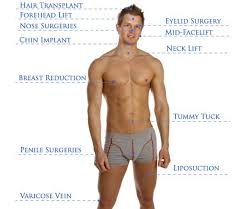
Your Choices of Breast Enhancement
Breast surgery has been around for more than a century. Each year an increasing number of women opt for cosmetic breast surgery, mainly augmentation (to enlarger size) surgery.
If you have thought long and hard about breast augmentation and have decided you want it, then you will next need to decide on what form of augmentation. Here there are two particularly popular forms of implants which are explained below:
Implants (Silicone or Saline)
Implants are perhaps the more common form of breast enhancement. These involve implanting a foreign object into the breasts as ‘fillers’ to pad these out. These implants can be placed wither directly below the skin, or can be ‘submuscular’ (which is recommended for those who already have larger breasts) and this will make some difference to the appearance. At the same time there are different types of implants that can be used, though most often silicone implants are used. While saline implants (bags filled with a mixture of salt and water) can also be effective and have their own advantages, these are more prone to aesthetic problems which can include rippling and other problems.

History of cosmetic breast surgery
Breast augmentation surgery involves placing of a silicone gel-filled implant in the intrices of breasts with the aim to enhance size.
Implants made of different materials have been tried in the past; use of silicone implants began in 1962. The commonest kind of breast implants used today are saline and silicone implants.
• Saline implants – as the name suggests, these are filled with sterile salt water which is either pre-filled or can be filled in at the time of the procedure. Saline implants requires a smaller incision (as compared to silicone implants) – this is usually taken under the crease of the breast or the armpit and thus is very hard to detect.
• Silicone gel-filled implants – are made of a silicone gel and come only in pre-filled variety. Although, these require a much larger incisions, they are much safer than the saline ones – chances of an infection greatly decrease with silicone based implants.
This information is brought to you courtesy of Dr. Mark Bishara and The Paragon Plastic Surgery & Med Spa
Background
Although men do not face the same hormonal changes with aging that women do, the male biological clock still ticks, and over time changes in a man’s appearance can lead to a negative self-image, which can take a toll on mental and physical health. Today, men are turning to cosmetic surgery in an effort to help break the cycle of interaction between appearance and negative self-image. Because of this emerging trend, more male patients will be asking their trusted primary care providers for advice in navigating the potentially treacherous world of cosmetic surgery.
Whether in the public eye or leading a more private life, many men put forth energy, effort, and income to maintain a healthy, youthful appearance. Increasing access to more affordable, innovative, and less invasive forms of cosmetic surgery has resulted in more men turning to cosmetic procedures in an effort to look and feel younger. In fact, the American Society of Plastic Surgeons 2010 Report of Plastic Surgery Statistics indicates that of the 12.6 million plastic surgery procedures conducted annually, over 1.1 million were performed on men — a dramatic increase from the 225,009 procedures performed on men in 2000. Demonstrating their cost-effectiveness in these challenging economic times, minimally invasive procedures, such as botulinum toxin injections (Botox) and fillers, were up more than 9% from the prior year in 2010-2011. The more costly operative procedures that men undergo in large numbers include robotic hair transplants, nose reshaping (rhinoplasty), liposuction, cosmetic eyelid surgery (blepharoplasty), and facelifts, as well as surgery to correct male breast enlargement (mastopexy).
The ideal cosmetic plan maintains a life-stage balance of facial and body appearance that allows one to look their best throughout adult life. At earlier stages in life, avoiding excessive sun exposure, toxins from smoking, and recreational drug use will help to stall the progression of environmentally related aging changes. Later, avoiding significant weight fluctuation minimizes the development of loose or flabby skin. Body issues unrelated to such lifestyle factors as diet and exercise are best addressed once bone and soft tissues have reached maturity. For some, a time may come when surgery is considered for body issues unrelated to lifestyle, and plastic surgery may be the best option to help maintain a healthy self-image.
When selecting a plastic surgeon, patients should be sure to consider expertise and board certification. It is important to do the research and be patient with the selection process, because it can take some time. Patients should consider the procedure carefully and discuss with the surgeon whether a procedure is the right step to help meet their goals; this is an important part of the process because cosmetic surgery is not the answer for everyone. Patients should consult with their physician so that they can ask the correct questions in order to move forward appropriately.
A plastic surgeon will help identify patients whose body image goals and objectives may not be met with an operation alone. Postponing surgery with referral to a nutritionist, exercise trainer, or internist may be the appropriate outcome of the initial consultation. For surgery that is entirely elective, all patients should be close to their ideal health before having an operative procedure. If lifestyle choices and habits are not addressed preoperatively, the results of most cosmetic surgeries will be transient and therefore ultimately not worthwhile.
The following is a guide to help men look and feel their best throughout the lifespan.
Men in Their 30s
A man’s circulating testosterone level begins to decrease after age 30 years, with loss of lean muscle mass averaging 1% a year. Because of this, the most important thing a man can do to keep himself looking youthful is to continue building and maintaining his muscle mass. A regular program of cardiovascular fitness paired with weight training is essential to mitigate the natural aging process of decreased muscle mass. Proper hydration and attention to rest and diet are reflected in a healthier, more youthful appearance.
At this stage, age-maintenance procedures that are less invasive and are cost-effective can deliver results that look far more natural than other, more radical surgical choices. Skin care, sun avoidance, and proper use of sunblock are also crucial at this and every life stage.
Men in Their 40s
The use of botulinum toxin injection (Botox) and fillers has become much more common among men in their 40s and 50s, who are beginning to deal with the loss of facial skin elasticity. Because a man’s face has a more robust blood supply than a woman’s face, surgeons performing any personal enhancement treatments on the face must consider such factors as the depth of skin peeling, energy levels for light base treatments, and frequency of past use of topical medications.
The most common aesthetic procedure for men in this age group involves rejuvenation around the eyes. Blepharoplasty (eyelid surgery), when done well, can help revitalize a man’s face in a discreet manner, without announcing to the world that a cosmetic procedure was performed.
Men in Their 50s and Beyond
Regardless of age, encourage your patients to take a planned, realistic, and conservative approach to achieving their ideal body image. Less favorable cosmetic surgery outcomes among men, such as those seen in Bruce Jenner, Mickey Rourke, and Burt Reynolds, can and should be avoided with the guidance and support of surgeons who demonstrate a clear understanding of what cosmetic surgery options are available, along with knowledge of overarching health concerns.
At the office of Dr. Mark Bishara and The Paragon Plastic Surgery & Med Spa, we provide a wide range of cosmetic procedures to help patients look and feel their best. These procedures are designed to improve the appearance of the face and body through minimally invasive techniques that provide highly effective results. Many of these procedures can be combined in order to achieve your desired appearance. Please call our office to find out more about us at (817) 473-2120 or visit our website at www.MarkBisharaMD.com.

For those looking to improve their breast shape and/or size, breast augmentation is an option to explore. But through exploration, many women come across the same questions and concerns, leaving them to wonder what they should and shouldn’t believe. What are the most common myths regarding breast implants:
1) Saline is safer than silicone.
False. Saline implants were largely used because silicone implants were thought to cause medical problems. In scientific studies and in real life, silicone implants perform equal to or better than saline implants, which are filled with salt water. They produce more of a natural feeling. However saline implants require less surveillance and don’t necessitate MRIs.
2) Under the muscle is more natural looking than over the muscle.
False. The practice of placing breast implants under the pectoralis major muscle depends on individual breast anatomy and the type of breast implants selected. Some patients get better, more natural-looking results with the breast implants under the pectoralis major muscle, while others over the muscle. It really depends on your unique anatomy.
3) You cannot breast feed after you have had a breast augmentation.
False. When a breast augmentation is done via an incision through the inframammary fold, armpit or belly button, there is not usually a problem with breast-feeding.
4) Natural breast augmentation with fat is better than breast implants.
False. Taking a person’s own fat with liposuction and adding it to the breasts may create future problems because some of the fat transferred will perish within a year. It’s a new technology, and there is no regulatory approval in the U.S., so the technique is not yet standardized. So at this point, the procedure is very controversial, and there is concern about the long-term safety and efficacy.
5) You need breast implants for a breast lift.
False. Breast implants are not a treatment for breast sagginess. Only a breast lift (mastopexy) corrects sagginess.
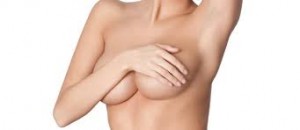
For more information regarding breast augmentation, breast lift (mastopexy), or breast revision please contact the office of Dr. Mark Bishara, with offices in both Mansfield and Southlake, TX. Dr. Bishara provides a wide range of cosmetic procedures to help patients look and feel their best. These procedures are designed to improve the appearance of the face and body through minimally invasive techniques that provide highly effective results. Please contact our office at (817) 473-2120 or visit our website at www.MarkBisharaMD.com.
Click here for more information on Breast Augmentation

Michelle Obama, who turned 50 over the weekend, isn’t ruling out using plastic surgery or Botox in the future.
“Women should have the freedom to do whatever they need to do to feel good about themselves,” the first lady told People magazine in an interview hitting newsstands Friday, her birthday. “Right now, I don’t imagine that I would go that route, but I’ve also learned to never say never.”
Her message to women is to be healthy. Mrs. Obama says she has never missed a health checkup, including mammograms and Pap smears. She’s also had a colonoscopy.
“I don’t obsess about what I eat, but I do make sure that I’m eating vegetables and fruit,” added Mrs. Obama. “And as everyone knows, I do exercise.” Her “Let’s Move” campaign to reduce childhood obesity rates through the combination of exercise and healthier eating enters its fifth year next month.
Her workouts have also evolved from weight-bearing and cardio exercises to include things like yoga that she says will help keep her flexible.
Asked whether she has peaked at 50, Mrs. Obama joked that being first lady is “pretty high up.” She said she’s always felt that her life is “ever-evolving” and she doesn’t have the right to “just sit on my talents or blessings.”
“I’ve got to keep figuring out ways to have an impact, whether as a mother or as a professional or as a mentor to other kids,” the first lady said, noting that daughter Malia, now 15, will be in college when she and President Barack Obama leave the White House in January 2017. Daughter Sasha, 12, won’t be far behind.
“At that point in life, whoa, the sky is the limit,” Mrs. Obama said.
Despite her nonchalance about her upcoming milestone, Mrs. Obama noted that some things can still make her feel older. “Well, there are those times when your staff tell you they were born the year you were graduating from college. It’s like, really? Really? That hurts,” she said, laughing. “But I don’t feel that much differently than I did when I was younger.”
President Obama told People that he’s “always in awe” of his wife as she approaches her 50th birthday.
“Michelle is actually more beautiful now than when I met her,” he said. “And I think she’s wiser.”
Beyonce and Stevie Wonder rocked the White House at a star-studded, late-night dance party celebrating first lady Michelle Obama’s 50th birthday, which was planned by Barack Obama.
At 50, she’s got some of the most envied arms, a killer wardrobe, and quite the social life. Happy 50th Birthday, Michelle Obama!
This News is Brought to You Courtesy of Dr. Mark Bishara and The Paragon Plastic Surgery & Med Spa in Mansfield and Southlake, TX
Plastic Surgery Procedures (Body Contouring) After Weight Loss
Most patients who undergo gastric bypass, or some form of gastric banding procedure, do lose weight. Many lose a lot of weight. But this massive weight loss brings problems of its own.
Typically patients are left with large folds of excess skin, along with loose muscles and sometimes localized pockets of unsightly fat tissue. In such cases, bariatric plastic surgery procedures, body contouring procedures and lipoplasty (liposuction), can help to reshape the normal structures of the body in order to improve appearance and self-esteem.
Plastic surgery is not an easy option. Mostly, it involves exchanging one cosmetic problem (eg. loose skin) for another (scars).
Plastic Surgery Procedures to Remove Loose Skin and Fat
For patients suffering from morbid or malignant obesity, choosing bariatric surgery to reduce calorie intake may offer them a passport to a healthy life. But even if such surgery causes them to lose substantial amounts of weight, they may face new problems which may necessitate further operations.
Plastic Surgery to Remove Loose Skin
When bariatric surgery (eg. gastric bypass) leads to dramatic weight loss, excessive amounts of skin can accumulate and hang in various areas, including face, neck, breasts, upper and lower abdomen, flanks, armpit, back, buttocks, arms, forearms, thighs, legs, and calves. This surplus skin can cause considerable hygienic problems, skin irritation, skin breakdown, pain and infection.
Plastic Surgery Procedures to Remove Excess Residual Fat
In addition, even though the patient might have experienced massive weight reduction, this weight loss may not be evenly spread around the body. This also depends on the patient’s type of obesity condition (whether gynoid or android). Body Contouring procedures can help to reduce these fat deposits, either by surgical excision or lipoplasty.
Cost of Plastic Surgery Procedures
The price of bariatric-related plastic surgery procedures can vary significantly, depending on several factors.
- Patient’s condition
- Complicating factors
- The plastic surgeon
- The hospital chosen
- The type of anesthesia
- Complications arising
Patient’s Needs
The full cost of your plastic surgery procedure is unlikely to become clear until after you have been examined by your surgeon, and your individual requirements and needs ascertained. Even then, you may need follow-up procedures after your plastic surgery.
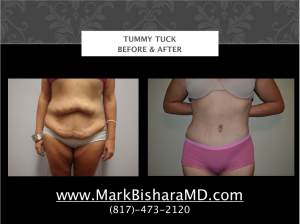
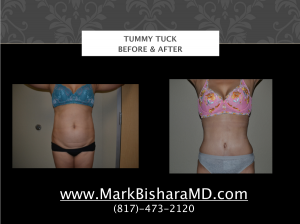
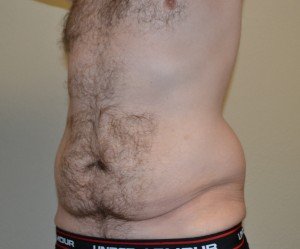
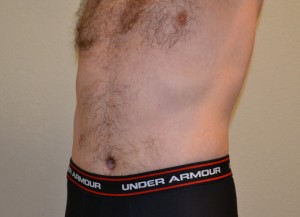


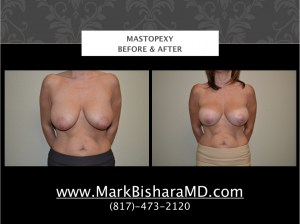
Body Contouring Surgery Options
- Abdominoplasty (tummy tuck)
- Arm Lift (brachioplasty)
- Body lift (Circumferential Panniculectomy)
- Breast Lift (Mastopexy)
- Breast Reduction (Women)
- Buttock Lift
- Face Lift
- Forehead Lift
- Male Breast Reduction (Gynecomastia)
- Liposuction (Lipoplasty)
- Thigh lift (Thighplasty)
Dr. Bishara will discuss these and other treatment options with you during your consultation to determine which procedures are right for you. Our treatment plan is specifically designed for patients who have recently undergone bariatric surgery and are left with loose, sagging skin as a result of the extreme weight loss. Please call our office at (817) 473-2120 for more information or to schedule a consultation or visit our website at www.MarkBisharaMD.com for more pictures of body contouring patients.

